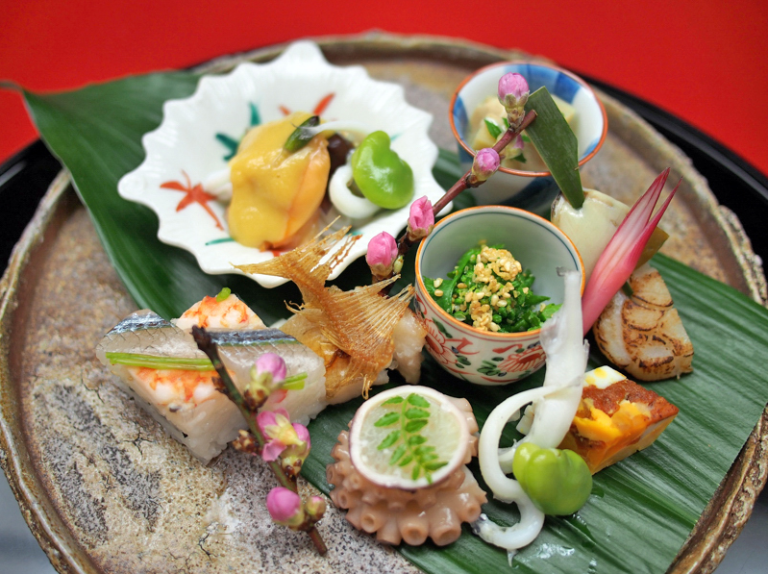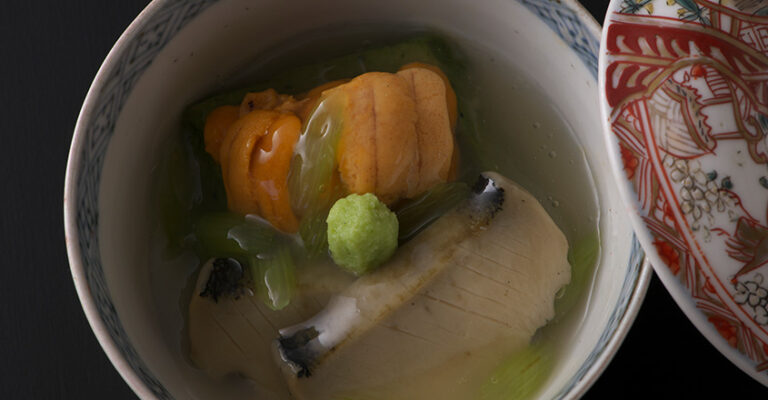Japan has more Michelin stars than anywhere on earth. Here perhaps more than anywhere else in the world, food is rich with both flavor and culture – and no experience compares to kaiseki in Kyoto. The delicate, seasonal art of kaiseki is the most intense dining experience in Asia: two hours and more than a dozen dishes. In Kyoto, it’s important to do kaiseki right.
Originating in 1827 during the late Edo period, current Head Chef Motokazu Nakamura is proudly the sixth generation of his family to continue the art of making kaiseki, creating intricate dishes in small servings.
Having earned three Michelin Stars, this traditional kaiseki cuisine is served in private rooms. Upon entering Nakamura, guests are greeted by staff adorned in traditional Japanese dress before being asked to remove their shoes to sit down.
The chef’s specialty, a shiro-miso zoni soup dish, is made without yellow broth, which is meant to highlight the miso and guji-no-sakayaki flavors of the dish. Reservations for Nakamura are required and the restaurant is closed to the public on Sundays.
HANA-KITCHO
Set against cherry blossom trees, which are blooming unusually early this year, Hana-Kitcho’s cuisine, as prepared by Chef Teiichi Yuki, is designed with care and presented in traditional kaiseki style, a dining experience meant to stimulate all five senses.
The Arashiyama Bamboo Forest surrounds the three-star Michelin restaurant and the menu changes with the season, and Hana-Kitcho devotes itself to serving only the freshest of ingredients. Fresh crab, river prawns, and handmade tofu are menu regulars.
KICHISEN

ABOVE: Kichisen’s fare can boast three Michelin Stars.
Surrounded by the Tadasu-no-mori forest, all that’s left of the woods that once shaped the Yamashiro Province, lies Kichisen – located nearby the UNESCO World Heritage site of the Shimogamo-jinja shrine.
Boasting three Michelin Stars, special engagements include private geisha performances and live music. Head Chef Yoshimi Tanigawa, also the founder of the restaurant, has been passionate about cooking since age nine and began cultivating his professional culinary career at 15. After appearing on the critically acclaimed television show, Iron Chef, Chef Tanigawa gained international popularity by beating host Masaharu Morimoto 3-0.

ABOVE: Kaiseki dish at Kichisen.
Guests can enjoy the chef’s signature dishes in courses starting with dashi soup. Dashi, made from bonito flakes and kelp, kickstarts the dining experience with the warmth and nutrients of a light broth.
TSURUYA

ABOVE: Tsuraya seating area.
Formerly a private residence, this large establishment was renovated in 1964 and is now the home to the Michelin-rated restaurant known as Tsuruya. Guest can enjoy an enchanting interior that once entertained European royalty and politicians. The restaurant closes toward the end of each year and guests are highly recommended to make reservations for parties more than three persons; children under the age of 12 are not permitted.
ABOVE: A selection of dishes at Tsuraya.
Six- or seven-course meals can be had in private rooms or the unique stone-top tempura bar, which wraps around the front portion of the kitchen allowing guests to view the magic as it happens. Only the freshest seasonal ingredients are featured in the menu, serving lunch and dinner.
ABOVE: Hyotei was originally a tea house and inn.
With a history dating back more than 300 years, Hyotei originally opened its doors as a tea house and inn, and a section of the property is still dedicated to serving tea.
The winner of three Michelin stars, this restaurant focuses on balancing the texture, decor, and taste. Signature dishes are centered around the delicate Hyotei egg.
ABOVE: A selection of dishes from Hyotei.
It is important to note that restaurant is closed on the second and fourth Tuesday of every month and reservations are required. The kaiseki cuisine is served in the main building between the hours of 11am and 7.30pm.



















